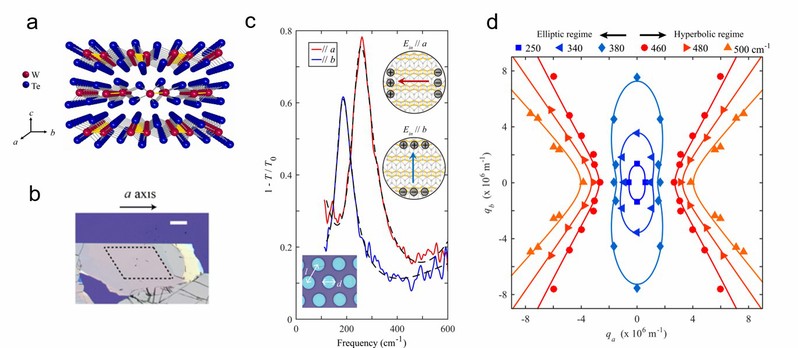
Recently, a research group led by Prof. Yan Hugen from the Department of Physics at Fudan University reported the observation of natural hyperbolic plasmon resonance modes in 2D material WTe2 films in the far-IR range. That is the first experimental evidence of hyperbolic plasmon polaritons, which was previously only realized in artificial metasurfaces, proving its existence on a natural surface. The findings were published online in Nature Communications entitled “Van der Waals thin films of WTe2 for natural hyperbolic plasmonic surfaces” on Mar. 3. The first author is Wang Chong, a post-doctor in the group.
After decades of fast development, the information industry has hit a bottleneck where integrated circuits and chips cannot be further scaled down due to challenges such as heat effect and quantum size effect. Many therefore have turned to plasmon resonance, which is collective oscillation of electrons that can control light beyond the diffraction limit at a scale much smaller than the light wavelength, so that light signals can be transmitted in very small dimensions of devices. This remarkable capability triggers the development of next-generation information technologies for highly integrated photonic systems, nano-resolution optical imaging techniques and nanoscale electronic circuits. Recently, hyperbolic plasmon has attracted much research attention due its extremely large field confinement and highly directional propagating property, enabling a series of potential applications for planar photonics, such as nanoscale imaging, negative refraction and enhancement of spontaneous emission. In contrast to the plasmon on an isotropic surface, hyperbolic plasmons exist on surfaces with extremely anisotropic conductivity along the two principle axes. However, the hyperbolic plasmons have only been realized in metamaterials and metasurfaces with artificial structures, which limits the field confinements and photonic density of states due the structure size. This calls for the natural hyperbolic materials with no artificial structures. While many materials, e.g. black phosphorous, have been predicted in theory to sustain hyperbolic plasmons, no such experimental demonstration has been reported yet.
Semimetal WTe2 is one of the layered materials that possess in-plane anisotropic electrodynamics (Fig. a), and hosts a wide range of remarkable electronic properties, such as extremely high mobility, tunable carrier density, and being a candidate of type-II Weyl semimetals. The reflection experiments of bulk WTe2 in previous works demonstrates a conductivity sign-changing regime in far-IR range, indicating the potential to realize the hyperbolic plasmons. However, no observation of the hyperbolic plasmons modes was reported due to the experiment restriction.

Yan’s group studied the plasmon resonance modes based on exfoliated WTe2 films by Fourier transform-infrared spectrometer (Fig. b). By reducing the light absorption by moisture, the signal/noise ratio is greatly enhanced, and the anisotropic plasmon resonance modes are successfully measured (Fig. c). In addition, the plasmon frequency and anisotropy exhibit strong temperature dependence. By mapping the plasmon dispersion and intensity evolution with frequency, the hyperbolic range is demonstrated in the wavelength range from 16 to 23 microns. The topological transition from the elliptic regime to the hyperbolic regime is revealed by the iso-frequency contours as shown in Fig. d, which provides a defining evidence for the existence of hyperbolic plasmons.
The discovery of hyperbolic plasmons on WTe2 films sets a foundation for the manipulation of plasmon propagation, light-matter interaction and light emission in planar photonics. According to Yan, WTe2 is just one of the layered semimetal materials that possess intriguing properties. This work will stimulate the study of plasmons in many other layered materials.
Editor: Deng Jianguo, Li Yijie